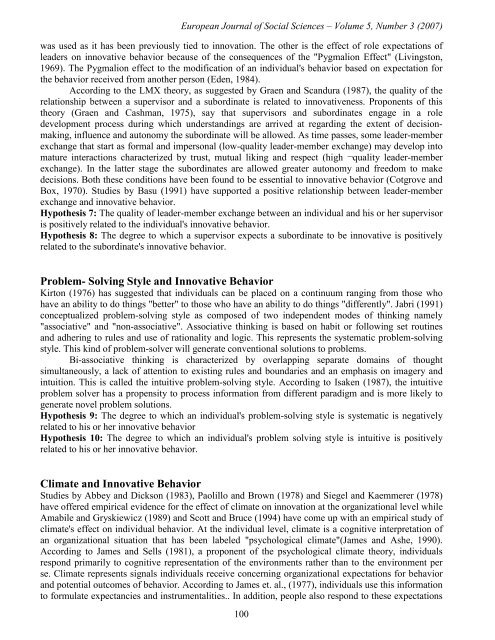european journal of social sciences issn: 1450-2267 - EuroJournals
european journal of social sciences issn: 1450-2267 - EuroJournals
european journal of social sciences issn: 1450-2267 - EuroJournals
You also want an ePaper? Increase the reach of your titles
YUMPU automatically turns print PDFs into web optimized ePapers that Google loves.
European Journal <strong>of</strong> Social Sciences – Volume 5, Number 3 (2007)<br />
was used as it has been previously tied to innovation. The other is the effect <strong>of</strong> role expectations <strong>of</strong><br />
leaders on innovative behavior because <strong>of</strong> the consequences <strong>of</strong> the "Pygmalion Effect" (Livingston,<br />
1969). The Pygmalion effect to the modification <strong>of</strong> an individual's behavior based on expectation for<br />
the behavior received from another person (Eden, 1984).<br />
According to the LMX theory, as suggested by Graen and Scandura (1987), the quality <strong>of</strong> the<br />
relationship between a supervisor and a subordinate is related to innovativeness. Proponents <strong>of</strong> this<br />
theory (Graen and Cashman, 1975), say that supervisors and subordinates engage in a role<br />
development process during which understandings are arrived at regarding the extent <strong>of</strong> decisionmaking,<br />
influence and autonomy the subordinate will be allowed. As time passes, some leader-member<br />
exchange that start as formal and impersonal (low-quality leader-member exchange) may develop into<br />
mature interactions characterized by trust, mutual liking and respect (high ¬quality leader-member<br />
exchange). In the latter stage the subordinates are allowed greater autonomy and freedom to make<br />
decisions. Both these conditions have been found to be essential to innovative behavior (Cotgrove and<br />
Box, 1970). Studies by Basu (1991) have supported a positive relationship between leader-member<br />
exchange and innovative behavior.<br />
Hypothesis 7: The quality <strong>of</strong> leader-member exchange between an individual and his or her supervisor<br />
is positively related to the individual's innovative behavior.<br />
Hypothesis 8: The degree to which a supervisor expects a subordinate to be innovative is positively<br />
related to the subordinate's innovative behavior.<br />
Problem- Solving Style and Innovative Behavior<br />
Kirton (1976) has suggested that individuals can be placed on a continuum ranging from those who<br />
have an ability to do things "better" to those who have an ability to do things "differently". Jabri (1991)<br />
conceptualized problem-solving style as composed <strong>of</strong> two independent modes <strong>of</strong> thinking namely<br />
"associative" and "non-associative". Associative thinking is based on habit or following set routines<br />
and adhering to rules and use <strong>of</strong> rationality and logic. This represents the systematic problem-solving<br />
style. This kind <strong>of</strong> problem-solver will generate conventional solutions to problems.<br />
Bi-associative thinking is characterized by overlapping separate domains <strong>of</strong> thought<br />
simultaneously, a lack <strong>of</strong> attention to existing rules and boundaries and an emphasis on imagery and<br />
intuition. This is called the intuitive problem-solving style. According to Isaken (1987), the intuitive<br />
problem solver has a propensity to process information from different paradigm and is more likely to<br />
generate novel problem solutions.<br />
Hypothesis 9: The degree to which an individual's problem-solving style is systematic is negatively<br />
related to his or her innovative behavior<br />
Hypothesis 10: The degree to which an individual's problem solving style is intuitive is positively<br />
related to his or her innovative behavior.<br />
Climate and Innovative Behavior<br />
Studies by Abbey and Dickson (1983), Paolillo and Brown (1978) and Siegel and Kaemmerer (1978)<br />
have <strong>of</strong>fered empirical evidence for the effect <strong>of</strong> climate on innovation at the organizational level while<br />
Amabile and Gryskiewicz (1989) and Scott and Bruce (1994) have come up with an empirical study <strong>of</strong><br />
climate's effect on individual behavior. At the individual level, climate is a cognitive interpretation <strong>of</strong><br />
an organizational situation that has been labeled "psychological climate"(James and Ashe, 1990).<br />
According to James and Sells (1981), a proponent <strong>of</strong> the psychological climate theory, individuals<br />
respond primarily to cognitive representation <strong>of</strong> the environments rather than to the environment per<br />
se. Climate represents signals individuals receive concerning organizational expectations for behavior<br />
and potential outcomes <strong>of</strong> behavior. According to James et. al., (1977), individuals use this information<br />
to formulate expectancies and instrumentalities.. In addition, people also respond to these expectations<br />
100

















